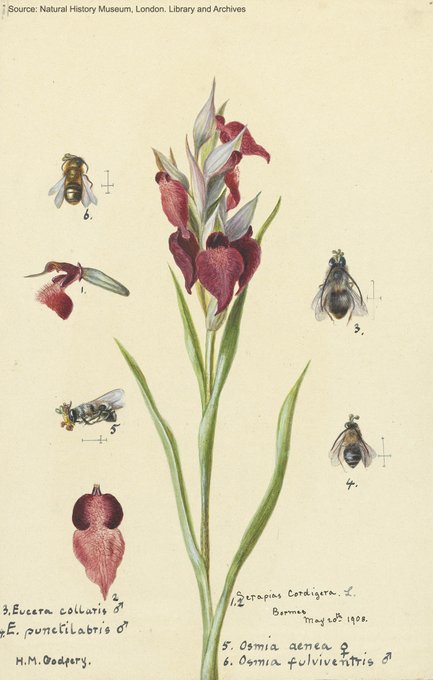extraordinaryorchidsのTwitterイラスト検索結果。 10 件
The helmet #orchid, Corybas fimbriatus, is a small plant that grows on the forest floor. This image was painted by Ferdinand Bauer (1760-1826), artist on Matthew Flinders' #Investigator voyage which circumnavigated #Australia 1801-1803 #ExtraordinaryOrchids
Phew.... #Botany2021 talk uploaded, not perfect but hey ho, nothing ever is! And its community that counts #iamabotanist - can't wait to hear all the cool science. I am also doing an author chat on the 23rd - about #ExtraordinaryOrchids @UChicagoPress @NHM_London - come & visit!
With this Serapias cordigera Hilda Margaret Godfery (1871-1930) depicts the bees that visit the flowers. @SandyKnapp writes ‘Both male and female bees visit these flowers and shelter in the cavity provided by the arched sepals – no other reward is offered’ #ExtraordinaryOrchids
This #Masdevallia wageneriana was published in The Genus Masdevallia (1891-1896). The plates and text were by Florence H Woolward (1854-1936) who used the plants growing in the extensive #orchid collections of the Marquess of Lothian at Newbattle Abbey #ExtraordinaryOrchids
The #orchids that you commonly see for sale in supermarkets in the UK are unnamed #hybrids of #Phalaenopsis, or moth orchids. They can flower at any time of the year. This image is from James Bateman's A Second Century of Orchidaceous Plants (1867) #ExtraordinaryOrchids
This Bolbophyllum is from W J Hooker's A Century of Orchidaceous Plants (1849). In #ExtraordinaryOrchids, @SandyKnapp writes how the dark delicate hairs are thought to lure the dipteran pollinators of these tiny flowers by imitating a fly mating swarm #flyfriday #RareBooks
Georg Eberhard Rumphius (1627-1702) named Flos susannae (now Pecteilis gigantea) after his wife, Suzanna, who assisted his botanical work after he lost his sight. This image is from William Jackson Hooker's (1785-1865) A Century of Orchidaceous Plants (1849) #ExtraordinaryOrchids
Of this orchid flower, Ophrys apifera, painted by Arthur Harry Church (1865-1937) @sknapp writes 'the pollinaria appear to be dangling into the curve of the column. This drops the #pollen masses directly onto the stigma, self-pollinating the flower' #ExtraordinaryOrchids #NHMbook
1/2 On the front cover of #ExtraordinaryOrchids is Coryanthes speciosa, pl.36 of James Bateman's The Orchidaceae of Mexico and Guatemala ([1837]-1843). With a print run of only 125 copies, it remains one of the finest (and heaviest!) books on orchids ever published #rarebooks
New book alert! #ExtraordinaryOrchids by @SandyKnapp published by @NHM_London. Revealing the weird and wonderful lifestyles of this most diverse of #plant families, it is bursting with images from our original #art and published collections https://t.co/czzP3UhJ5A #Orchids #Books











